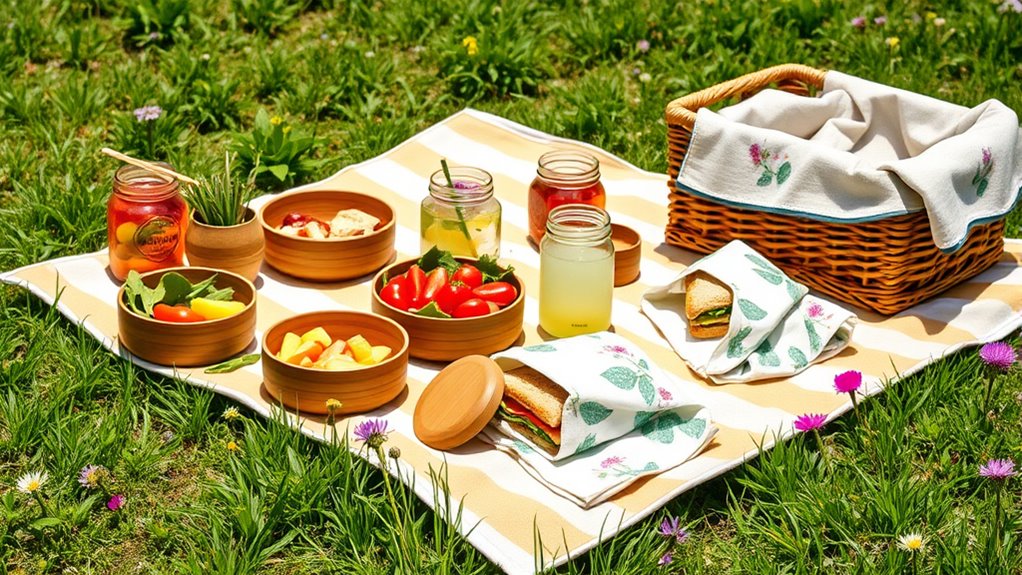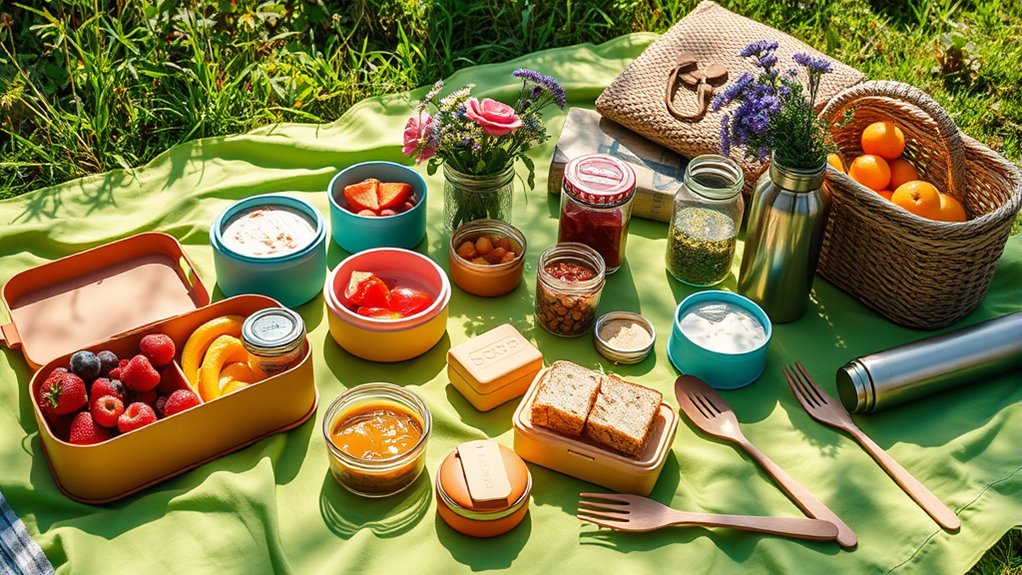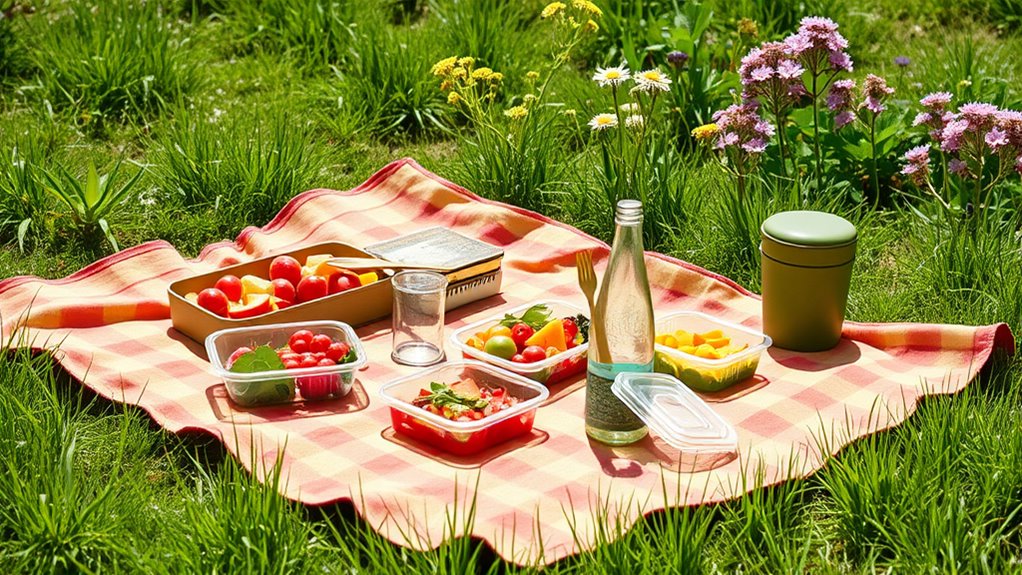To plan a zero-waste picnic, start by using sustainable containers like beeswax wraps and reusable utensils. Pack your food in sourced local produce and homemade dishes, avoiding pre-packaged snacks. Bring along a sturdy picnic basket, waterproof blanket, and cloth napkins for a comfy setup. Set up composting stations and educate your guests on waste management practices. With these tips, you’re on your way to a fun, eco-friendly outing—discover more ideas to enhance your picnic experience.
Key Takeaways
- Choose reusable containers, utensils, and beeswax wraps to minimize waste and avoid single-use plastics.
- Plan a menu using local, seasonal ingredients to support sustainability and reduce carbon footprint.
- Implement effective waste management by sorting recyclables and compostables in designated bags.
- Engage guests with educational materials on sustainability practices and encourage participation in waste reduction.
- Leave no trace by cleaning up thoroughly and respecting park guidelines during the picnic.
Choosing Sustainable Containers and Wraps

When you’re planning a zero-waste picnic, choosing sustainable containers and wraps is essential to minimizing your environmental impact.
Beeswax wraps are a fantastic alternative to plastic wrap; they’re reusable, biodegradable, and made from organic materials. These wraps keep your food fresh and can last for years with proper care, making them an eco-friendly choice that helps keep over a million pounds of plastic out of oceans. Ensuring that your food storage solutions are made from eco-friendly materials can significantly reduce your overall waste footprint. Additionally, using renewable resources like wood for your grilling or serving needs can further enhance the sustainability of your picnic. Utilizing products derived from sustainable forestry can also contribute to a greener picnic experience.
For containers, look for compostable options, like Vegware’s plant-based boxes. They’re lightweight and easy to transport, and they break down naturally, reducing waste.
Remember to pack reusable utensils and cloth napkins to further cut down on single-use items.
With these choices, you’ll enjoy your picnic while also protecting the planet, making each meal both delightful and eco-friendly.
Essential Reusable Picnic Supplies

Packing your picnic with the right reusable supplies can significantly enhance your zero-waste experience. Start with a sturdy picnic basket or a cloth tote bag to carry everything you need. If you prefer, an insulated backpack can keep food fresh while making transport easier. Additionally, consider including portable camping coolers to maintain the ideal temperature for perishable items. Sustainable living practices, such as curated lists, can help you select the best supplies for your picnic.
Bring waterproof blankets for comfort and to protect against damp ground. For eating, opt for bamboo utensils and stainless steel plates to avoid disposables. Reusable plates and utensils not only promote waste-free picnicking but also add a touch of style to your outdoor dining experience. Additionally, incorporating chia seeds into your picnic food can boost nutrition without creating waste.
Finally, make cleanup simple with cloth napkins and biodegradable trash bags. These essentials not only reduce waste but also create a pleasant and eco-friendly picnic atmosphere. Enjoy your time outdoors while caring for the planet!
Crafting a Zero-Waste Menu

Crafting a zero-waste menu not only elevates your picnic experience but also supports sustainable practices.
Start by focusing on local produce; visiting farmers’ markets helps you find fresh fruits and vegetables while reducing your carbon footprint. Opt for organic options and incorporate seasonal foods to further support local farmers. Additionally, choosing best training treats for dogs can enhance the experience for your four-legged companions during the picnic. Consider bringing along waterproofing treatments to protect your food from unexpected weather changes. Incorporating diversification strategies in your meal planning can help you create a varied and exciting menu.
Embrace homemade dishes like baked goods, dips, and savory salads using locally sourced ingredients. Consider sustainable protein options like veggie skewers, local cheeses, or grilled tofu. Additionally, using locally sourced ingredients can enhance the quality and freshness of your meals.
Don’t forget to repurpose leftovers creatively. Use fresh herbs and homemade spice blends to enhance flavors without relying on packaged seasonings.
Effective Waste Management Strategies

After you’ve crafted your zero-waste menu, the next step is to implement effective waste management strategies that align with your sustainable picnic goals.
Start by using compostable containers like molded fiber pulp packaging and bio boxes, which break down naturally and reduce landfill waste. Opt for reusable options, such as plates and utensils, and replace paper napkins with cloth alternatives. Incorporating eco-friendly containers into your picnic not only minimizes waste but also helps protect wildlife and the environment. Additionally, planning ahead with advance directives can ensure that your preferences are honored in any situation, including during a picnic. Using solar-powered solutions for your picnic lighting can further enhance your eco-friendly approach. Creating a clutter-free space will help you pack efficiently and reduce the amount of unnecessary items you bring along.
Utilize compostable containers and reusable utensils to minimize waste and enhance your eco-friendly picnic experience.
Bring a separate bag for collecting waste, sorting recyclables and compostables to minimize your environmental impact. It’s crucial to dispose of trash in designated bins and set up composting stations.
Lastly, avoid pre-packaged snacks and choose homemade goodies to further cut down on waste. With these strategies, you’ll ensure an eco-friendly picnic experience.
Engaging Guests in Sustainability Practices

To make your zero-waste picnic a success, engaging your guests in sustainability practices is essential. Start by providing clear instructions about sustainability before the event. Share educational materials that outline zero-waste practices and their environmental impact. Understanding the importance of reducing waste can significantly enhance your guests’ commitment to sustainable practices. Additionally, consider highlighting how aging in place can benefit from sustainable efforts, as it promotes a healthier environment for all. Incorporating best emergency preparedness strategies can also enhance the overall experience by ensuring everyone is ready for unexpected situations.
Set sustainability goals and encourage everyone to participate actively in reducing waste. You can even offer briefings to remind guests of these practices. It’s important to highlight that millions of pounds of trash end up in landfills annually, which can motivate guests to adopt more mindful consumption habits.
During the picnic, facilitate discussions about sustainability to keep the conversation going. Consider inviting a local sustainability expert to share insights.
Promote eco-friendly choices by encouraging guests to bring reusable items and introducing sustainable alternatives like biodegradable plates.
Lastly, foster a collaborative mindset, encouraging teamwork and sharing leftovers to minimize waste and enhance community spirit.
Fun and Interactive Activities for Everyone

Engaging your guests in sustainability practices sets the perfect stage for a variety of fun and interactive activities that everyone can enjoy at your zero-waste picnic.
Organize nature scavenger hunts to spark exploration and appreciation for the outdoors. Set up a Yard Twister game using natural chalk for some playful competition. Challenge your guests with picnic-themed trivia to add an intellectual twist. Additionally, incorporating healthier options into your picnic menu can inspire guests to create their own delicious dishes using fresh, local ingredients. You might even consider including educational toys that encourage creativity and teamwork. Offering frozen yogurt as a refreshing dessert can also align perfectly with the zero-waste theme by using seasonal fruits for a guilt-free treat. Consider providing multi-tool kits for guests to use, enhancing their ability to engage with the outdoor environment.
Foster creativity with group storytelling around the picnic blanket. For all ages, create environmental-themed quizzes and a waste-free picnic challenge that encourages recycling.
Host nature drawing competitions and cooking challenges using locally sourced ingredients. These activities not only entertain but also promote teamwork and sustainability, making your picnic memorable for everyone involved.
Tips for Leaving No Trace Behind

While planning a zero-waste picnic, it’s crucial to prioritize leaving no trace behind. Start by understanding park guidelines to avoid disruptions. Choose sustainable locations with good waste management and visit during off-peak hours.
Pack your food in reusable containers and use beeswax wraps instead of plastic. Bringing your own utensils and napkins can further reduce waste and promote eco-friendly practices. Additionally, understanding astrological compatibility can help you choose picnic partners who share your values on sustainability and respect for nature. Bringing homemade snacks to reduce packaging waste, and ditching single-use items for reusable alternatives is essential. Remember to pack it in, pack it out—bring all waste home for proper disposal. It’s also wise to carry a backup water container for emergencies, especially when picnicking in remote locations.
Educate your guests about waste separation and collaborate with local recycling programs. Respect nature by staying on paths and avoiding wildlife disturbances. It’s important to put your waste where it belongs to help keep natural environments clean and safe for all.
Frequently Asked Questions
What Are Some Eco-Friendly Alternatives to Traditional Picnic Blankets?
When you’re looking for eco-friendly alternatives to traditional picnic blankets, consider options like jute or sisal for their biodegradability and durability.
Wool blankets offer excellent insulation and can be sourced from recycled materials. Organic cotton is soft and free from harmful chemicals, while bamboo provides breathability and moisture-wicking properties.
Hemp blankets are another great choice, boasting UV resistance and antimicrobial benefits, ensuring you enjoy your picnic while being kind to the environment.
How Can I Make Homemade Snacks Quicker?
Quickly crafting delicious homemade snacks can be a breeze! Start by prepping produce in advance—chop veggies or slice fruits the night before.
Use simple, straightforward recipes, like trail mix or veggie dips, that require minimal ingredients. Batch bake cookies or muffins for easy treats.
Incorporate leftovers into your snacks to save time and reduce waste. Finally, focus on fast assembly, using pre-cut items to whip up satisfying sandwiches in seconds.
What Are the Best Reusable Items for Kids?
When you’re looking for the best reusable items for kids, consider durable tableware like Re-Play’s colorful sets, which are both fun and tough enough for little hands.
Stainless steel plates and bamboo options also offer sustainable choices.
Don’t forget cloth napkins; they’re easy to wash and can be made from recycled materials.
For snacks, opt for stainless steel containers and beeswax wraps to keep everything fresh while reducing waste.
Kids will love it!
How to Handle Food Allergies in a Zero-Waste Picnic?
When you’re managing food allergies, communication’s crucial. Consider collecting allergy concerns from your guests beforehand.
Keep cleanliness central to your preparations, ensuring all utensils are sanitized. To dodge dangerous allergens, limit foods like nuts and dairy, and pack potential culprits separately in labeled containers.
By prioritizing plant-based, homemade meals, you not only minimize allergens but also embrace eco-friendly practices.
Always carry emergency supplies, just in case someone needs assistance.
Can I Use Biodegradable Utensils Instead of Reusable Ones?
Yes, you can use biodegradable utensils instead of reusable ones.
They’re convenient for events where cleanup is tough, and they decompose naturally, reducing landfill waste.
However, keep in mind that while they’re portable and lightweight, they mightn’t withstand high heat like stainless steel.
If your focus is on minimizing waste and you don’t mind a bit of extra cost, biodegradable utensils can be a suitable choice for your needs.
Conclusion
As you pack your basket with vibrant, fresh fruits and delicious homemade treats, remember the beauty of a zero-waste picnic lies in its simplicity. Picture a sunlit meadow, laughter echoing as you and your friends savor each bite, all while leaving nothing behind but joyful memories. By embracing sustainable choices and engaging everyone in eco-friendly practices, you’ll not only nourish your bodies but also nurture the planet. So grab your reusable gear, and let’s make this picnic unforgettable!








